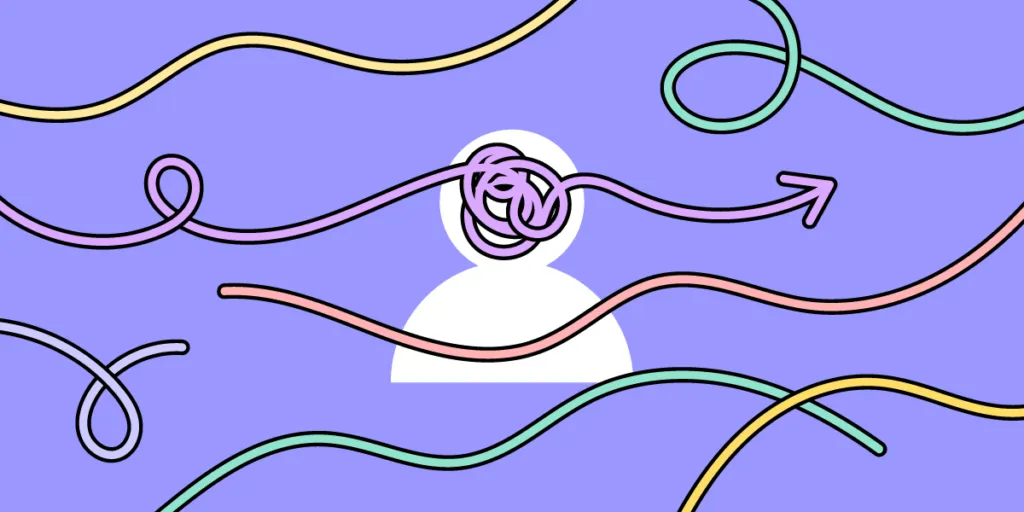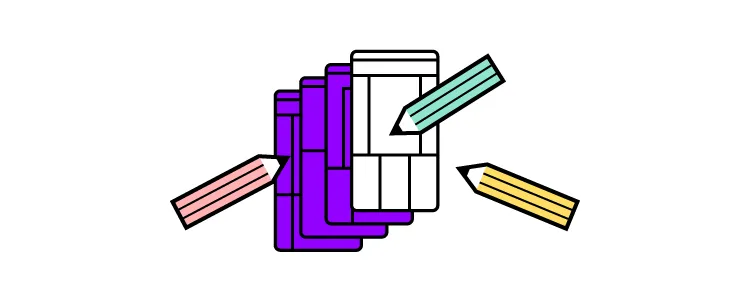22 Creative Design Thinking Exercises to Bring Your Team Closer Together

Design thinking exercises are crucial in fostering creative problem-solving, collaboration, and innovation. These exercises engage participants in a structured and iterative problem-solving approach, enabling them to explore, understand, and address complex challenges effectively.
Key takeaways:
- Design thinking exercises are structured activities or methods used to encourage and facilitate collaboration.
- These exercises foster creativity providing structured but open-ended frameworks for problem-solving.
- The list of design thinking exercises is huge; in this article, we elaborate on 22 of them.
Streamline design operations and enhance designer-developer collaboration with UXPin Merge. Visit our Merge page for more details and how to request access.
What is the Purpose of Design Thinking Exercises?
The primary purpose of design thinking exercises is to cultivate empathy and a deep understanding of users’ needs and perspectives. By encouraging participants to step into users’ shoes through empathy mapping and user interviews, design thinking helps uncover valuable insights that inform the design process.
These design thinking workshops create a user-centered environment that encourages collaboration and creativity. These activities empower design teams to challenge assumptions, explore diverse perspectives, and approach problems from multiple angles.
Design Thinking Exercises for Empathy and User Research
These design thinking activities enable teams to gain empathy and a user-centric perspective during the research phase, informing the design process and ensuring solutions align with user needs.
- Empathy mapping: Create visual representations of user perspectives by capturing their thoughts, feelings, actions, and aspirations. This exercise helps teams develop a deeper understanding of users’ experiences.
- Persona development: Create fictional user personas representing different user segments based on research and insights. Personas humanize user data, making it easier for teams to empathize and design for specific user groups.
- Customer journey mapping: Visualize users’ end-to-end experience as they interact with a product or service. This exercise helps identify pain points, opportunities, and moments of delight throughout the user journey.
Ideation and Brainstorming Exercises

Ideation and brainstorming exercises are essential to the design thinking process, aiming to generate a range of ideas and possible solutions. Designers use these exercises to foster creativity, drive collaboration, and explore new possibilities.
SCAMPER
SCAMPER is an acronym that stands for Substitute, Combine, Adapt, Modify, Put to another use, Eliminate, and Reverse. This technique prompts designers to creatively explore different dimensions of a concept or problem, encouraging alternative perspectives and generating fresh ideas.
Brainstorming sessions
Brainstorming is a group activity that encourages free thinking and the rapid generation of ideas. Participants share their thoughts, build on each other’s suggestions, and explore various possibilities without judgment or criticism.
Crazy 8s
Crazy 8s is a fast-paced exercise that challenges participants to sketch eight ideas in eight minutes. This time-constrained activity encourages rapid ideation and pushes participants to think outside the box, resulting in diverse concepts.
Mind mapping and concept mapping
Mind mapping and concept mapping are visual techniques that help organize thoughts and ideas. By creating diagrams or visual frameworks, designers can explore connections, relationships, and associations between different concepts, stimulating further ideation.
Design studio workshops
Design studio workshops unite cross-functional team members to generate ideas and potential solutions collaboratively. Participants share their perspectives, expertise, and insights through structured exercises and facilitated discussions, resulting in more comprehensive and well-rounded concepts.
Worst possible idea
This exercise challenges participants to devise the worst possible ideas or solutions deliberately. By exploring extreme and unconventional concepts, designers can break free from conventional thinking and uncover unexpected insights or alternative paths.
5 Ws and H
The 5 Ws and H (Who, What, When, Where, Why, and How) is a questioning technique that prompts participants to analyze and explore different aspects of a design challenge. By systematically considering these elements, designers can uncover new perspectives, identify potential gaps, and generate innovative solutions.
Prototyping and Testing Exercises

These prototyping and testing exercises offer valuable opportunities for designers to gather feedback, iterate on ideas, and validate design concepts.
Paper prototyping
Paper prototyping is a low-fidelity technique where designers create rough sketches or wireframe mockups on paper. This exercise lets designers quickly iterate and gather feedback on a design concept’s overall layout, content, and flow.
Designers can use paper prototypes to simulate user interactions and test usability, compiling valuable insights before investing time and resources into digital prototypes.
Role-playing and simulation
Role-playing and simulation exercises involve participants acting out specific scenarios or user personas to understand user needs and behaviors better. By immersing themselves in the end user’s perspective, designers can empathize with their experiences, identify pain points, and uncover opportunities for improvement.
Wizard of Oz testing
Wizard of Oz testing is a technique where designers simulate the functionality of an interactive system while manually controlling it behind the scenes. This methodology allows designers to test user interactions and gather feedback without investing time and resources in developing a fully functional prototype.
By creating the illusion of an automated system, designers can observe user behavior, validate assumptions, and refine the design based on real-time feedback.
Collaborative Exercises for Teamwork and Co-creation

Collaborative prototyping
Collaborative prototyping involves creating prototypes to test and validate design concepts within a day. Team members work in parallel on a single digital whiteboard and then collaborate using a design tool to build a prototype. By the end of the day, the team has a basic prototype to start the iterative process of prototyping and testing.
Co-design sessions
Co-design sessions bring together multidisciplinary team members and stakeholders to actively participate in the design process. These collaborative exercises foster teamwork and co-creation by leveraging the diverse perspectives and expertise of the participants.
By involving various stakeholders in the design process, co-design sessions facilitate shared understanding, generate innovative ideas, and ensure that the final design reflects the collective input and insights of the team.
Collaborative sketching
Collaborative sketching involves team members collectively sketching ideas and concepts on a shared surface or whiteboard. This exercise encourages open collaboration and rapid idea generation.
By visually expressing their thoughts, team members can communicate ideas more effectively, stimulate creativity, and spark discussions. Collaborative sketching promotes a sense of ownership while fostering teamwork.
Storyboarding and visual storytelling
Storyboarding and visual storytelling exercises help teams convey design ideas and concepts in a narrative format. This technique involves creating illustrations or images that depict user interactions, scenarios, or journeys.
Storyboarding allows teams to visualize the user experience and identify gaps or opportunities in the design. Teams can communicate complex ideas, align design directions, and create engaging user experiences.
Design charrettes
Design charrettes are intensive collaborative workshops where team members solve design challenges within a set timeframe. These super-efficient sessions encourage active participation, foster creativity, and promote collective problem-solving.
Design charrettes often involve brainstorming, rapid prototyping, and iterative design exercises. By engaging in focused and time-constrained collaborative activities, teams can generate ideas, explore design alternatives, and make significant progress in a short period.
Design Thinking Exercises for Reflection and Learning

Rose, Thorn, Bud
The Rose, Thorn, Bud exercise is a reflection activity that encourages participants to share positive aspects (roses), areas for improvement (thorns), and potential opportunities (buds) in a given project or experience.
Rose, Bud, Thorn helps teams identify strengths, address challenges, and explore new possibilities with a structured framework for reflection. The exercise enables team members to learn from past experiences and apply those insights to future iterations or projects.
Post-it voting
Post-it voting is a simple and effective technique to gather insights and prioritize ideas within a group. Participants write their ideas or suggestions on individual sticky notes and then vote on the most valuable or relevant ones.
This exercise promotes active participation and empowers team members to have a voice in decision-making. Post-it voting helps teams identify popular ideas, build consensus, and focus efforts on the most impactful concepts.
Four Ls
The Four Ls exercise (Liked, Learned, Lacked, and Longed for) provides a structured framework for reflection and feedback gathering. Participants share what they liked, learned, lacked, and longed for in a project or experience.
The Four Ls encourages constructive feedback, helps identify areas of improvement, and uncovers growth opportunities. The exercise promotes open dialogue and creates a safe space for team members to reflect on their collective experiences and identify ways to enhance future outcomes.
Retrospective exercises
Retrospective exercises are reflective activities conducted at the end of a project or iteration to evaluate the team’s performance and identify areas for improvement.
These exercises include team discussions, storytelling, timeline mapping, or even gamified approaches like “sailboat retrospective” or “stop, start, continue.”
Retrospectives foster a culture of continuous improvement by providing a dedicated space for teams to reflect on their successes, challenges, and lessons learned. These exercises enable teams to optimize processes, enhance collaboration, and evolve their practices.
Scale DesignOps With UXPin Merge
One of DesignOps’ biggest challenges is Merging design and development. These teams use different tools, speak different languages, and work with different constraints.
UXPin Merge aims to bridge that gap by bringing code components into the design process to create a Code-to-Design workflow. Designers and developers work with one component library from a single repository, creating a single source of truth across the organization.
This single source of truth eliminates many design system challenges, requiring fewer resources for product teams to scale and deliver products faster and with minimal errors or rework.
Scale your DesignOps–not your design team–with the world’s most advanced end-to-end design tool. Visit our Merge page to request access.




